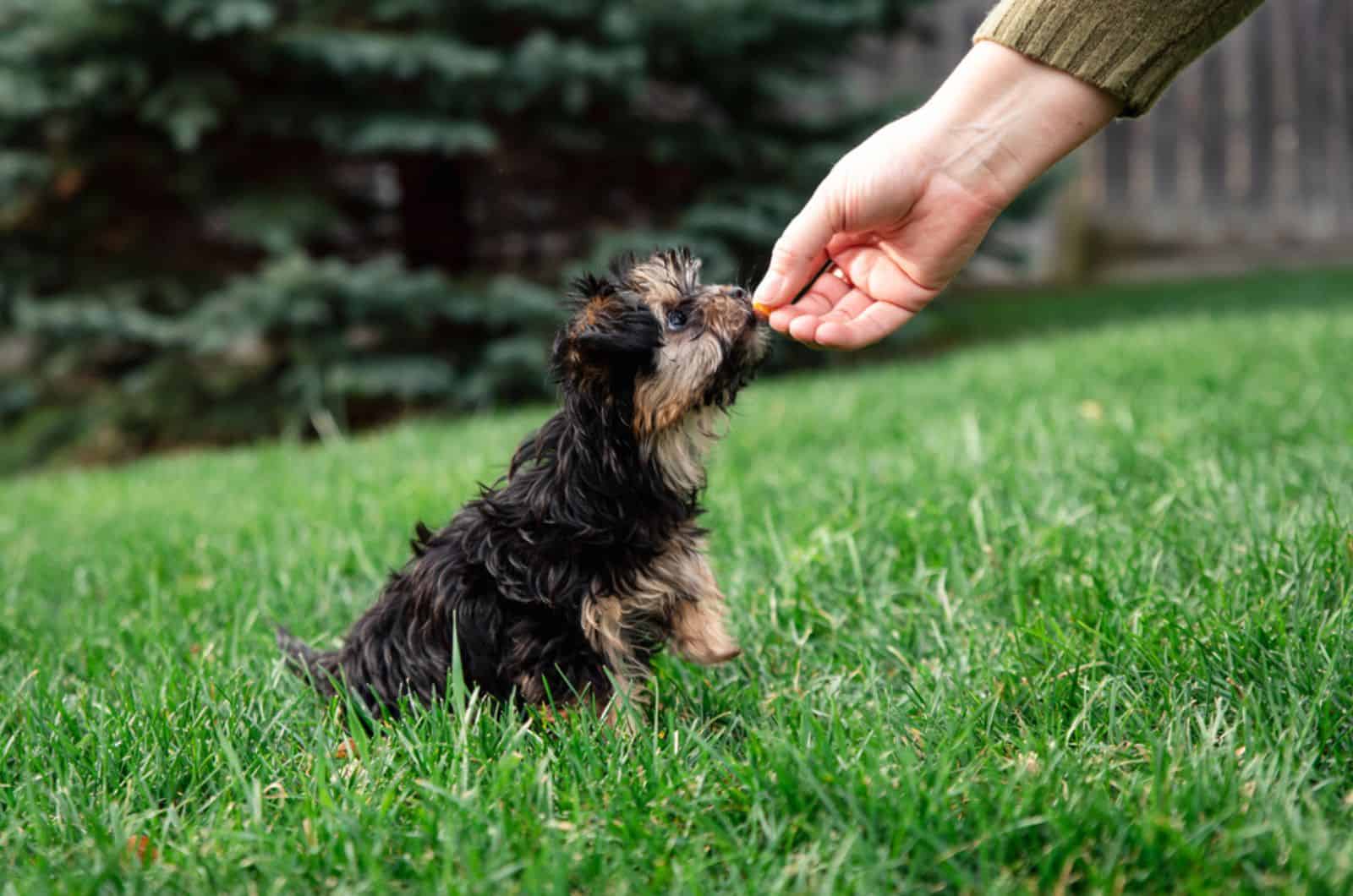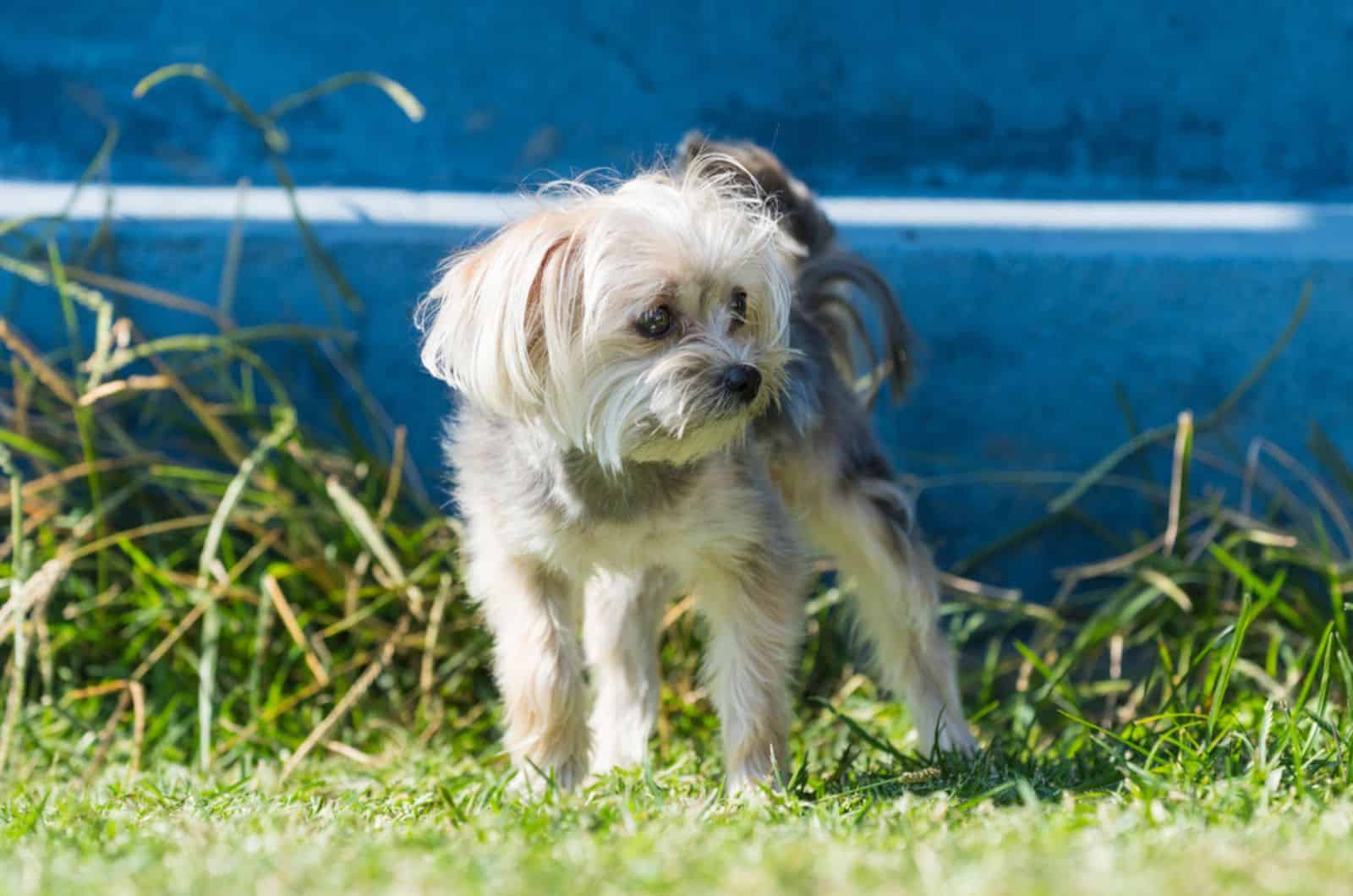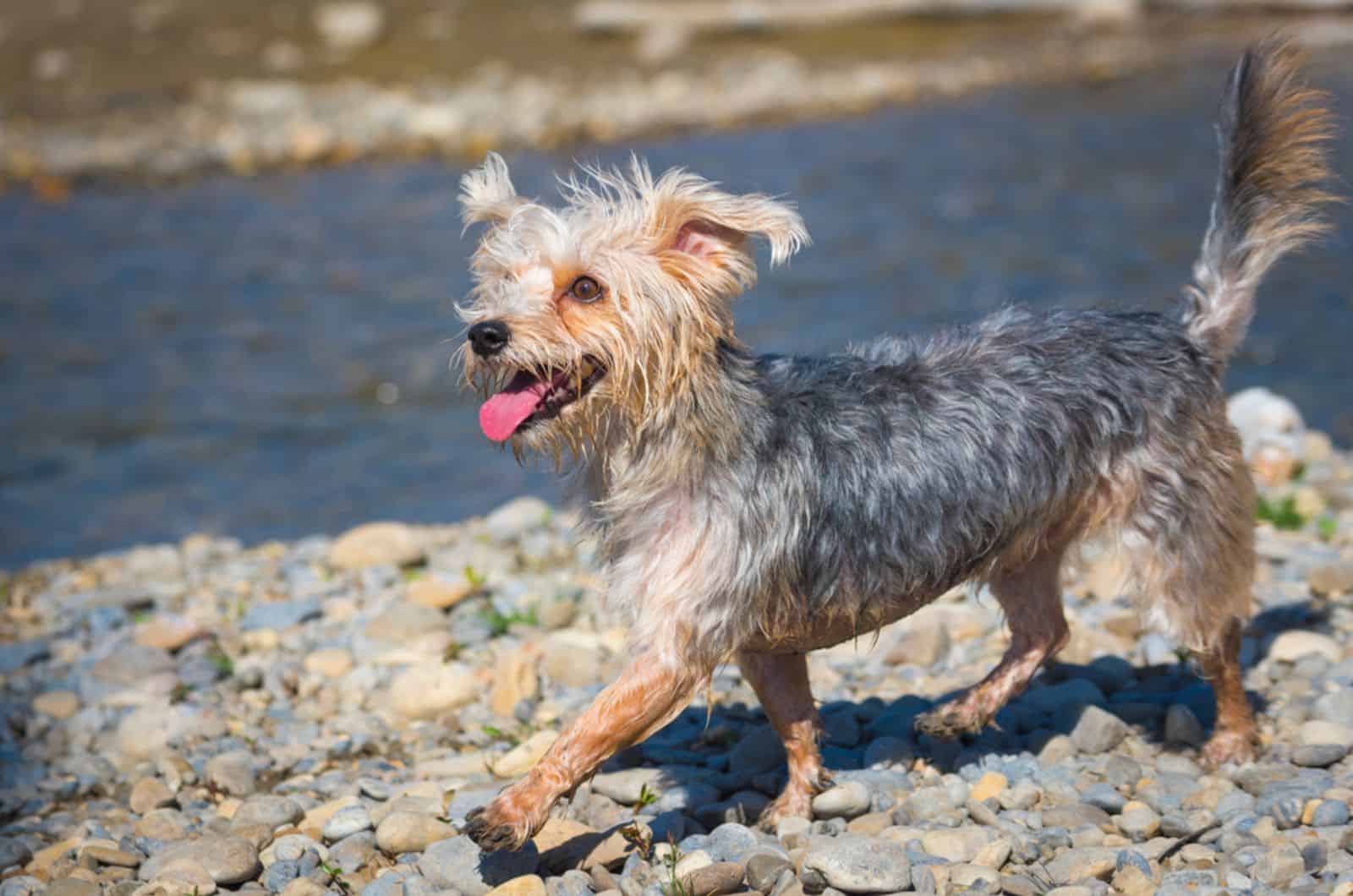If you’re planning to buy a Morkie puppy, one of the first things that you should do as a responsible pet owner is design the Morkie growth chart. That way, you will have a clear schedule to rely on as visualizing the growth of your future pet will help you anticipate its needs.
The Morkie, being a mix of a Yorkshire Terrier and a Maltese, is known as a hybrid toy dog. That said, these canines are perfect for an indoor life as they don’t require much space to begin with.
Still, their growth is a quite sensitive matter, especially if we take into consideration that Morkies can easily become overweight, or easily hurt. They require proper maintenance and care, and the breed is generally recommended for singles, families of adults, and senior couples.
Throughout this article, you will have the chance to see what Morkies look like throughout their stages, as well as what things impact their growth. So, let’s begin!
The Morkie Growth Chart
[table id=723 /]
Morkie Puppy Throughout Stages

Generally, both Maltese and Yorkshire Terrier parents happen to be toy breeds that don’t exceed 12 inches in height, and 8 pounds in weight.
Their offspring, the Morkie puppy, happens to weigh 4.5 to 7 pounds in its adulthood, while its average height revolves between 8 and 10 inches.
Their Maltese parents are generally bred for companionship purposes, as well as Yorkies. Still, these tiny pooches come with extra stamina in their pockets as they are not as lazy as they may seem.
Quite the contrary… both of these purebred pooches are eager to display their full sassiness once they become adapted to their new home.
However, their extra small size should be priority number one to new owners as they are easily hurt. They require careful maintenance and lots of attention in the first place.
Morkies are considered to be fragile throughout all life stages, which is why they shouldn’t leave the home without your supervision. But, prior to their socialization phase, let’s see what newborn Morkies look like!
From Birth To Two Weeks
The first two weeks are considered to be the most sensitive period in the Morkie growth chart. This is because newborn puppies are generally fragile, and they are not able to dictate their own pace.
That said, newborn Morkies are unable to maintain their normal body temperature, which is why they need to be close to their mother the whole time.
If, by chance, you pick up a Morkie puppy from a shelter before it has turned eight weeks of age, bear in mind several things. First, you should know that their mom’s milk is the only food they are allowed to eat in this period.
However, a proper milk replacer bought from your vet or a reliable pet shop will do it.
These Morkshire Terriers should never be fed with cow’s milk. They are naturally lactose intolerant during the first couple of weeks, and their stomach is generally still quite sensitive.
During the first two weeks, Morkies will most likely experience their first rudimentary crawling. That said, you will come across a plethora of unsuccessful attempts to crawl, but that’s fine. Newborn puppies are generally too weak to carry their own head.
At the end of the second week, Morkies will slowly open their eyes. Alongside that, you can expect the first teething symptoms such as drooling, nipping, inflamed gums, and whining.
From Three Weeks To Eight Weeks

The early puppyhood stage generally ends with the first weaning symptoms. That said, your Morkie will enter the weaning phase during the third week. This is the phase when puppies start drinking water, as well as eating their first gruel of healthy dog food.
During this age, Morkies start walking on their own without any problems. In week three, they are still too young to learn their first tricks. However, they should be slowly introduced to a potty, and to other family members, as Morkies generally take some extra time to adapt.
Even though their parents, Maltese, are categorized among the easiest dogs to potty train, Morkies’ owners will need patience and commitment to teach their pets how to properly go potty. Their Yorkie DNA might stand in the way of being as impeccable as their Maltese parents.
After the first month, these small-breed canines are ready to learn their first socialization manners. They are naturally easy-going and sociable, but they still need proper upbringing.
This especially goes for families that happen to have young children as these canines are not exactly the best dogs to have around children.
By the end of the eighth week, these Yorkie Maltese mixes are ready to meet their owner.
Make sure to pick up your future pet from a reliable breeder. That way, you will get a fully-vaccinated, dewormed, health-examined, and microchipped puppy with proper DNA tests done.
From Nine Weeks To Five Months
Puppies between two and five months are two to five pounds heavy, and their height revolves between five and eight inches. By the start of this age, Morkies are fully aware of their environment, and they are ready to exercise for half an hour on a daily basis.
These canines don’t need a lot of exercise as their body physique is not as athletic as in some large dogs, such as Poodles and GSDs.
Alongside its training, this hybrid breed will need the best dog food to remain healthy. That said, you should avoid standard-sized kibble as these canines don’t have as strong a jaw as some other breeds.
Still, they will need an appropriate amount of protein derived from meat, as well as healthy fats and green vegetables.
By the end of the fifth month, these small dogs slowly start entering their sexual maturity phase. This is an extremely sensitive period in your pet’s life as it goes through major hormonal changes.
If you notice that your dog starts acting weird all of a sudden – don’t worry. Those might be the first symptoms of your dog being in heat.
From Six Months To Eighteen Months

At six months of age, your puppy will probably be around 3.5 to 6 pounds in weight, and 7.5 to 9 inches in height. Despite the fact that this is a small dog, bear in mind that Morkies come from two small breeds with huge personalities.
That said, these canines will be a real treat both in their juvenile age and in their adulthood. They are naturally sassy, show-offs, and at times, mischievous, but in a cute, innocent way.
Still, puppies that enter sexual maturity can be overwhelming at times. This is why you should consider spaying or neutering your Morkie between six and twelve months of age.
It is much easier to subject your dog to these procedures during this age as spaying or neutering an adult dog might be much more complex.
The recovery period after spaying / neutering a dog at six to twelve months should not take more than seven days.
According to the breed standard, your puppy should be fully socialized and well-mannered after the first six months.
Adult Morkie
Even though these puppies can enter their adult size months before their actual adulthood, they are not considered to be mentally mature until they reach two years of age.
In most cases, Yorkie Maltese dog mixes are fully grown at twelve months of age. However, puppies at this age might still have occasional outbursts and excessive behavior.
This is why you should not stop socializing, nor obedience training your dog until it enters its adulthood age.
When it comes to the Morkie growth chart, these puppies will be 4.5 to 7 pounds in weight, and 8 to 10 inches in height on average.
Adult puppies should generally be given around 0.5 cups of healthy dog food per day. Another thing related to the healthy growth of your Morkie is that you feed it at least three times a day.
Unlike large dogs, these puppies will need consistent meals to maintain their energy levels within a normal range.
You should expect your adult canine to be significantly less restless as adult Morkies are more of lap dogs. Still, this is not a completely lazy dog breed as these puppies will enjoy occasional frolicking in a dog park or in a back yard.
They love being mentally stimulated, and they won’t burn out to please their owner. A normal, thirty-minute exercise will make them lose their energy, after which they will crave a nice protein meal.
Senior Morkie

As most of these puppies live up to 15 years, Morkie dogs generally enter their senior years at nine or ten years of age. Both Morkie’s parents are prone to obesity, which is why they need to be kept at their normal adult weight throughout their entire lifespan.
Obesity in senior Morkies can lead to heart problems and diabetes, which generally shortens the lifespan and makes their quality of life poor.
In fact, it is recommended for Maltese owners to give their pets only the healthiest and best treats from the market as this purebred puppy is known for its heart failure problems.
Senior puppies will still have the need to go for an occasional walk. However, their exercise needs will be significantly reduced. You can expect your senior pet to be much less enthusiastic about physical activities, and much more enthusiastic about food.
That said, you should avoid large meals or late meals for that matter. As their activity level reduces, senior puppies can easily gain undesirable weight. Unlike puppy weight, senior weight is not susceptible to any fluctuations.
The exception will be dogs with hypothyroid disorder, cancer, or diabetes.
4 Determinants Affecting The Morkie Growth Chart

Not all puppies grow the same as not all of them have the same life circumstances. Even though, according to the ideal puppy weight chart, these canines reach up to 7 pounds, some dogs can be either bigger or smaller.
The same goes for their height. Average Morkies are 8 to 10 inches tall from their withers, but they can either be shorter or taller by a few inches.
The Morkie puppy growth chart is affected by several things, including genetics, health, gender, dietary habits, and exercise. These hybrids are generally considered to be healthy dogs that don’t meet major health problems.
Still, some Morkies can suffer from several conditions such as hypoglycemia, progressive retinal atrophy, eye, ear, and heart problems.
1. Genetics And Health
Genetics plays an important part in the Morkie growth chart. It practically determines everything – how big a dog will be, what DNA it will have, and what coat color a dog will come in.
It is quite unrealistic to expect a Morkie coming from two extremely small parents to appear big.
On the contrary, the offspring of two large parents is highly unlikely to be small. That’s why if you want to anticipate the size of your future pet – the best way to do so is to take a look at its parents first.
Both parent dogs of a Morkie puppy are considered to be toy breeds. That’s why your puppy will most likely be the same.
On the other hand, a dog’s health issues can play a significant role in its development. Even though none of the Morkie’s parents are considered to be among the healthiest dog breeds in the world, both breeds are respectably healthy.
However, there are some health issues that may affect this breed such as hypoglycemia, progressive retinal atrophy, obesity, diabetes, eye problems, and heart failure.
Obesity is one of those conditions that directly affect the Morkie growth chart as obese puppies tend to be bigger.
However, in most cases, this is not a hereditary issue as puppies get obese due to unhealthy feeding habits, which is one of the following growth determinants.
2. Gender
The Morkie’s size is highly dependent on its gender. For instance, male puppies are generally bigger by a few pounds and inches, and females stay below 7 pounds and 10 inches.
However, in some rare cases, female puppies can be as big as their male counterparts, or even bigger.
Still, just like their parents, both genders are equally affectionate, loveable, and sensitive. For instance, both male and female Maltese can face severe separation anxiety if left alone for more than a few hours.
The same goes for Morkie dogs despite their gender.
3. Feeding
Feeding is probably one of the most sensitive topics in the Morkie growth chart book of rules. Giving your new puppy a treat can be heart-melting at first, but it can also turn out to be your worst nightmare.
These hybrid canines are wise enough to outsmart you as they will do anything for an extra treat. This is why you should always choose healthy snacks for your puppy as giving them unhealthy treats may be fatal in the long run.
The same goes for dog food – you should avoid poor-quality dog food brands, as well as standard-sized kibble. While the first can result in excessive weight gain, the latter can affect your puppy’s jaw.
On the other hand, feeding your dog less than three times a day may result in undesirable weight loss. These puppies need consistent meals in order to maintain their energy level within a normal ratio. This is why they should not be fed once or twice a day.
If, by chance, you happen to feed your dog according to schedule, and it still loses weight – you should pay your veterinarian a visit as soon as possible. Excessive weight loss out of nowhere may be a sign of some disease.
4. Exercise
Even though it may seem that feeding and exercise are two separate issues – they really are not! In fact, exercise and feeding are codependent as one without the other doesn’t make any sense.
That said, you should always feed your dog at least two to three hours prior to exercise. On the other hand, your puppy should always eat after exercising as they burn off a lot of energy during training sessions.
While exercise can be a great way to bond with your dog, it is also quite important for its growth. The Morkie growth chart highly depends on exercise as it helps your puppy stay within a normal weight ratio.
On the other hand, puppies that lack daily exercise are most likely to be overweight, which doesn’t do good to them in the long run, neither physically nor mentally.
Exercise is a great way to teach puppy manners as sometimes, positive reinforcement techniques, such as interactive dog toys, petting, or praising are not enough.
FAQs

The average lifespan of these hybrid dogs revolves between 11 and 15 years. Generally, both of the Morkie’s parents are categorized among small, fluffy dog breeds that happen to have a quite respectable lifespan.
That said, you can expect your Morkie to reach 15 years as well.
Still, there are several things that determine the lifespan of this tiny breed. The first is health. Puppies with serious heart disease tend to live less.
Furthermore, an obese puppies’ lifespan can trigger a plethora of diseases in the long run such as cataracts, diabetes, or heart failure. The last two reduce their lifespan significantly.
Despite the fact that these canines come from two teacup dog breeds, Morkie puppies are generally fed with biological proteins, meat proteins, green vegetables, and healthy fats.
On the other hand, you should avoid giving your pet standard-sized kibble as Morkies don’t have as strong of jaws as some larger breeds. Furthermore, table scraps, junk food, and processed carbs are also foods to be avoided.
Additionally, you can use healthy snacks as a positive reinforcement tool during training sessions. Puppies that are given either unhealthy snacks or too many treats tend to get overweight faster.
These canines are generally healthy dogs that can easily live up to 15 years of age. However, some Morkies face health problems such as progressive retinal atrophy, patellar luxation, heart failure, eye and ear infections, and hypoglycemia.
Luckily, the majority of these issues are treatable and preventable. In order to prevent serious heart damage to your dog, you should take care of its feeding habits and exercise needs.
On the other hand, regularly groomed, bathed, and brushed puppies won’t face as many infections as unmaintained puppies.
To Sum Up
The Morkie growth chart is one of the most essential topics in your pet’s guidebook. By estimating your dog’s weight throughout its life stages, you can anticipate your dog’s needs as well as see what your dog will look like in adulthood.
If you’re a Morkie enthusiast, you should know that these canines happen to be excellent family dogs due to their toy size. They don’t require much space to begin with, and they just adore spending time with their owner.
If, by chance, you already have a Morkie by your side, hopefully you can get some benefit for future parenthood.
Related content: The Ultimate Maltese Growth Chart For All Pet Parents
